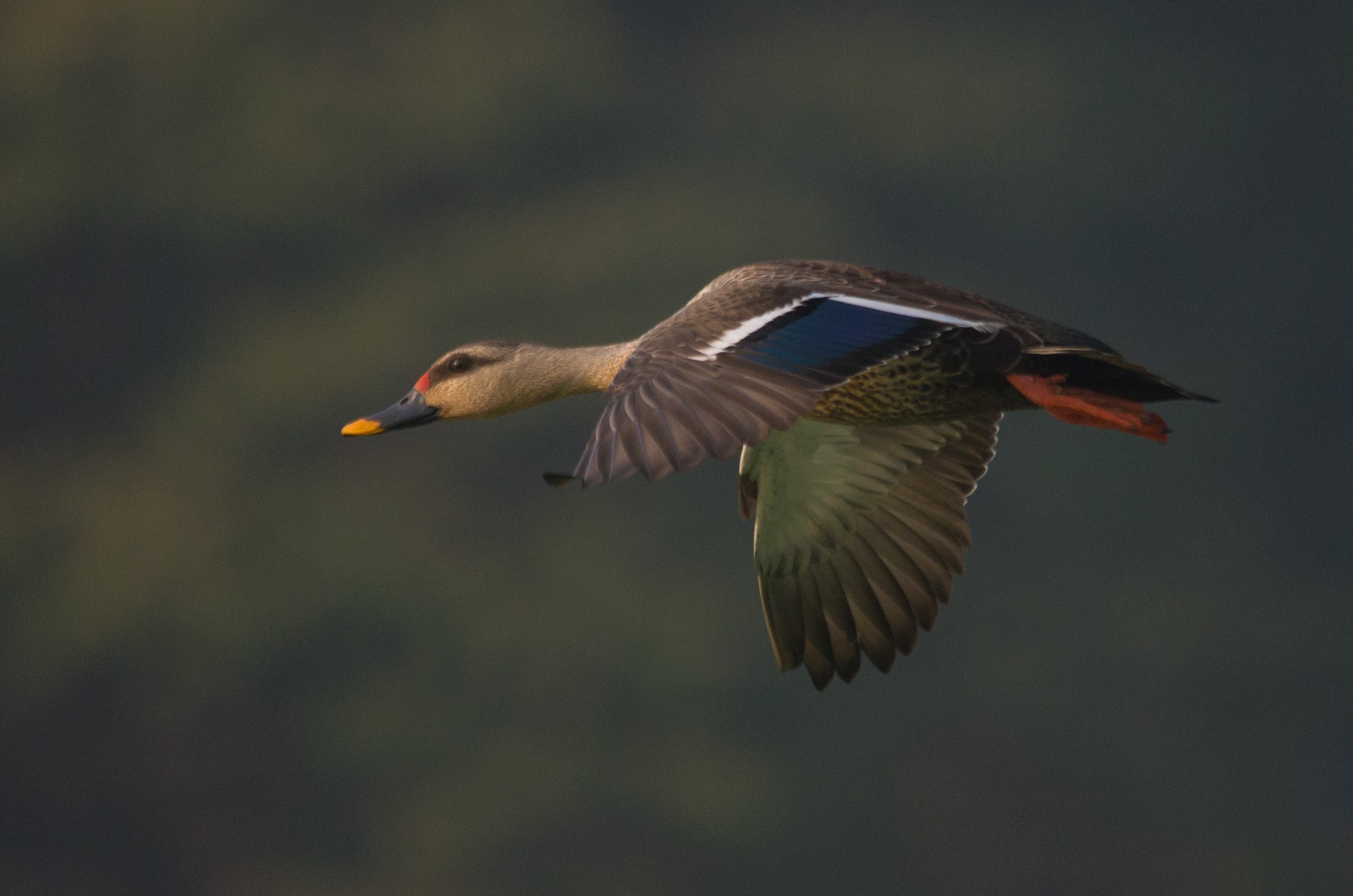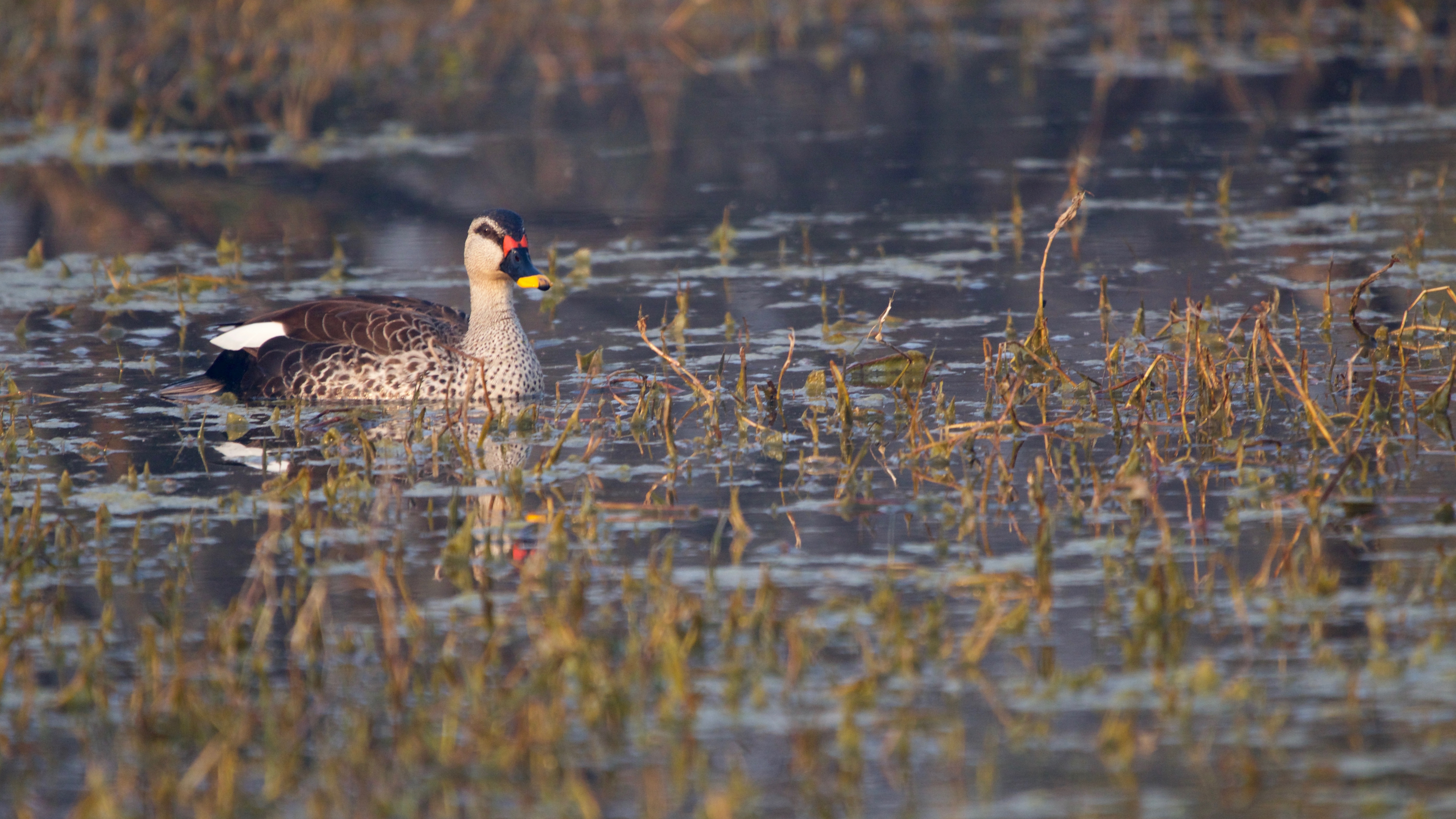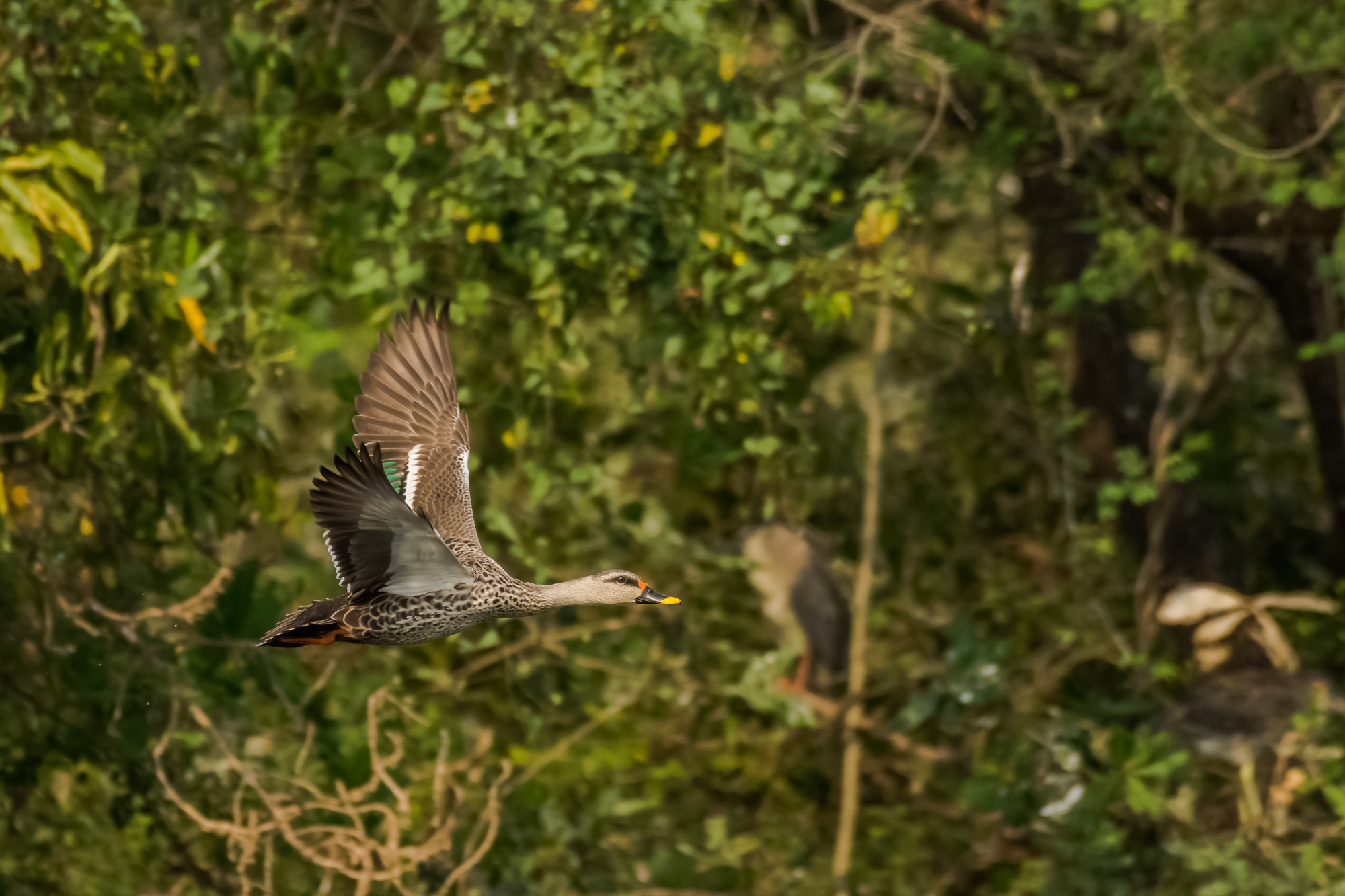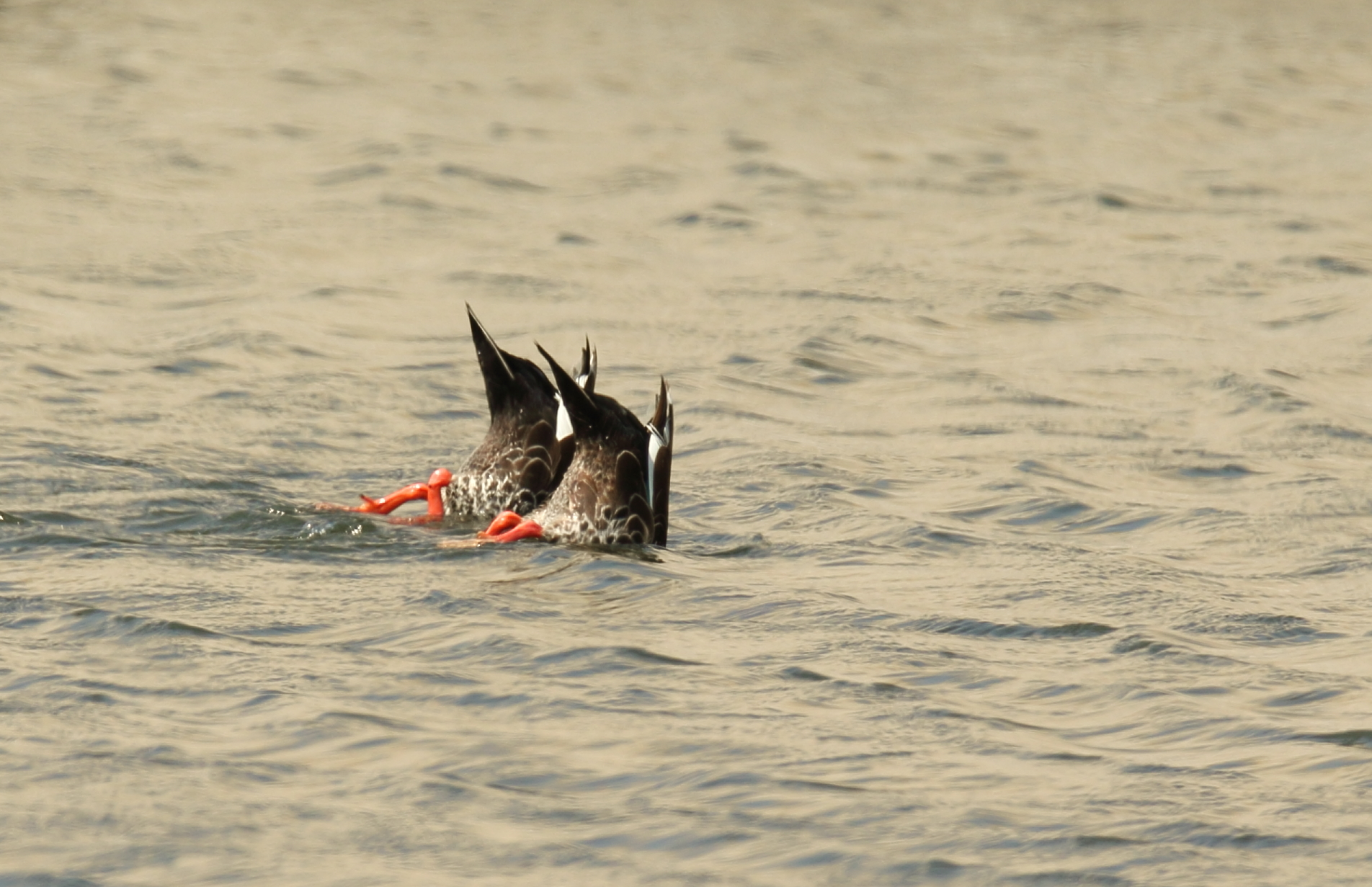Indian Spot-billed Duck on:
[Wikipedia]
[Google]
[Amazon]
The Indian spot-billed duck (''Anas poecilorhyncha'') is a large

 The Indian spot-billed duck was described by the naturalist
The Indian spot-billed duck was described by the naturalist
 This duck is around the same size as a
This duck is around the same size as a
 This
This
 It is a bird of freshwater
It is a bird of freshwater  Both the male and female have
Both the male and female have  They are seen isolated from other species and usually in pairs or small groups and when disturbed they can take off easily and nearly vertically from the water. They were hunted extensively in British India, noted for their excellent taste. When shot at, especially when in moult, they are known to dive and remain underwater to evade capture. A local name for it was "gheret-pai" or "garam-pai". In southern India, a method of hunting involved using floating bundles of rushes on which the hunters lay in wait. Natural predators of the ducks include birds of prey and terrestrial predators including pythons and otters.
They are seen isolated from other species and usually in pairs or small groups and when disturbed they can take off easily and nearly vertically from the water. They were hunted extensively in British India, noted for their excellent taste. When shot at, especially when in moult, they are known to dive and remain underwater to evade capture. A local name for it was "gheret-pai" or "garam-pai". In southern India, a method of hunting involved using floating bundles of rushes on which the hunters lay in wait. Natural predators of the ducks include birds of prey and terrestrial predators including pythons and otters.
File:Spot-billed Duck AMSM8294.jpg, Duck showing spot on bill
File:Spot-billed Duck AMSM8308.jpg, At
Xeno-canto: audio recordings of the Indian spot-billed duck
{{Taxonbar, from=Q839542
dabbling duck
The Anatinae are a subfamily of the family Anatidae ( swans, geese and ducks). Its surviving members are the dabbling ducks, which feed mainly at the surface rather than by diving. The other members of the Anatinae are the extinct moa-nalo, a yo ...
that is a non-migratory breeding duck throughout freshwater wetlands in the Indian subcontinent. The name is derived from the red spot at the base of the bill that is found in the mainland Indian population. When in water it can be recognized from a long distance by the white tertials that form a stripe on the side, and in flight it is distinguished by the green speculum with a broad white band at the base. This species and the eastern spot-billed duck
The eastern spot-billed duck or Chinese spot-billed duck (''Anas zonorhyncha'') is a species of dabbling duck that breeds in East and Southeast Asia. This species was formerly considered a subspecies of the Indian spot-billed duck and both were ...
(''A. zonorhyncha'') were formerly considered conspecific, together called the spot-billed duck (''A. poecilorhyncha'').
Taxonomy

 The Indian spot-billed duck was described by the naturalist
The Indian spot-billed duck was described by the naturalist Johann Reinhold Forster
Johann Reinhold Forster (22 October 1729 – 9 December 1798) was a German Continental Reformed church, Reformed (Calvinist) pastor and natural history, naturalist of partially Scottish descent who made contributions to the early ornithology of ...
in 1781 under its current binomial name
In taxonomy, binomial nomenclature ("two-term naming system"), also called nomenclature ("two-name naming system") or binary nomenclature, is a formal system of naming species of living things by giving each a name composed of two parts, bot ...
''Anas poecilorhyncha''. The name of the genus ''Anas'' is the Latin word for a duck. The specific epithet ''poecilorhyncha'' combines the classical Greek words ''poikilos'' meaning "pied" or "spotted" and ''rhunkhos'' meaning a "bill".
A molecular phylogenetic
Molecular phylogenetics () is the branch of phylogeny that analyzes genetic, hereditary molecular differences, predominantly in DNA sequences, to gain information on an organism's evolutionary relationships. From these analyses, it is possible to ...
study published in 2009 that compared mitochondrial DNA
Mitochondrial DNA (mtDNA or mDNA) is the DNA located in mitochondria, cellular organelles within eukaryotic cells that convert chemical energy from food into a form that cells can use, such as adenosine triphosphate (ATP). Mitochondrial D ...
sequences from ducks, geese and swans in the family Anatidae
The Anatidae are the biological family of water birds that includes ducks, geese, and swans. The family has a cosmopolitan distribution, occurring on all the world's continents except Antarctica. These birds are adapted for swimming, floating ...
found that the Indian spot-billed duck was a sister species
In phylogenetics, a sister group or sister taxon, also called an adelphotaxon, comprises the closest relative(s) of another given unit in an evolutionary tree.
Definition
The expression is most easily illustrated by a cladogram:
Taxon A and t ...
to a clade
A clade (), also known as a monophyletic group or natural group, is a group of organisms that are monophyletic – that is, composed of a common ancestor and all its lineal descendants – on a phylogenetic tree. Rather than the English term, ...
containing the Mexican duck
The Mexican duck (''Anas diazi'') is a species of dabbling duck that breeds in Mexico and the southwestern United States. Distribution and habitat
Most of the population is resident, but some northern birds migrate south to Mexico in winter. Th ...
, the American black duck
The American black duck (''Anas rubripes'') is a large dabbling duck in the family Anatidae. It was described by William Brewster in 1902. It is the heaviest species in the genus ''Anas'', weighing on average and measuring in length with an ...
, the mottled duck
The mottled duck (''Anas fulvigula'') or mottled mallard is a medium-sized species of dabbling duck. It is intermediate in appearance between the female mallard and the American black duck. It is closely related to those species, and is sometime ...
and the mallard
The mallard () or wild duck (''Anas platyrhynchos'') is a dabbling duck that breeds throughout the temperate and subtropical Americas, Eurasia, and North Africa, and has been introduced to New Zealand, Australia, Peru, Brazil, Uruguay, Arge ...
. A 2014 study, however, shows that there is discordance between the phylogenies obtained using nuclear DNA sequences; the Indian spot-bill appears to be closer to the Laysan
Laysan (; haw, italics=no, Kauō ), located northwest of Honolulu at , is one of the Northwestern Hawaiian Islands. It comprises one land mass of , about in size. It is an atoll of sorts, although the land completely surrounds a shallow ...
and Hawaiian duck
The Hawaiian duck (''Anas wyvilliana'') or koloa is a species of bird in the family Anatidae that is endemic to the large islands of Hawaii. Taxonomically, the koloa is closely allied with the mallard (''A. platyrhynchos''). It differs in that it ...
s and forming a sister clade to the New World and Old World mallards and the Mexican, American black and mottled ducks. There is significant hybridization between Old World mallards and eastern spot-billed ducks, leading to a closeness in their mitochondrial DNA that alters the apparent phylogenies.
Two subspecies
In biological classification, subspecies is a rank below species, used for populations that live in different areas and vary in size, shape, or other physical characteristics (morphology), but that can successfully interbreed. Not all species ...
are recognised although intergradation is possible (intermediates between ''haringtoni'' and eastern spot-billed duck have been recorded):
* ''A. p. poecilorhyncha'' Forster, 1781 – India and Sri Lanka
* ''A. p. haringtoni'' (Oates, 1907) – Myanmar to southern China and Laos (named after Herbert Hastings Harington
Herbert Hastings Harington (16 January 1868 – 8 March 1916) was a British Indian Army officer and ornithologist who worked in Burma and wrote on the birds of the region.
Harington was born in Lucknow to Herbert Harington of the Oudh Commis ...
(1868–1916))
The eastern spot-billed duck
The eastern spot-billed duck or Chinese spot-billed duck (''Anas zonorhyncha'') is a species of dabbling duck that breeds in East and Southeast Asia. This species was formerly considered a subspecies of the Indian spot-billed duck and both were ...
was formerly considered as a third subspecies. Fieldwork carried out at Hong Kong
Hong Kong ( (US) or (UK); , ), officially the Hong Kong Special Administrative Region of the People's Republic of China ( abbr. Hong Kong SAR or HKSAR), is a city and special administrative region of China on the eastern Pearl River Delt ...
in southern China and published in 2006 found that although both the eastern spot-billed duck and the Indian spot-billed duck (subspecies ''A. p. haringtoni'') bred in the region at the same time, mixed pairs were only very rarely observed. Based on this observation most taxonomists now treat the eastern spot-billed duck as a separate species.
Description
 This duck is around the same size as a
This duck is around the same size as a mallard
The mallard () or wild duck (''Anas platyrhynchos'') is a dabbling duck that breeds throughout the temperate and subtropical Americas, Eurasia, and North Africa, and has been introduced to New Zealand, Australia, Peru, Brazil, Uruguay, Arge ...
and has a scaly patterned body with a green speculum bordered by white. At rest the white stripe stands out and the long neck and the bill with yellow tip and orange red spots at the base are distinctive in the nominate subspecies. The red spots at the base of the bills are absent in ''haringtoni''. It measures in length and across the wings, with a body mass of . These are mainly grey ducks with a paler head and neck and a black bill
Bill(s) may refer to:
Common meanings
* Banknote, paper cash (especially in the United States)
* Bill (law), a proposed law put before a legislature
* Invoice, commercial document issued by a seller to a buyer
* Bill, a bird or animal's beak
Plac ...
tipped bright yellow. The wings are whitish with black flight feathers below, and from above show a white-bordered green The male has a red spot on the base of the bill, which is absent or inconspicuous in the smaller but otherwise similar female. The male does not have an eclipse plumage
Plumage ( "feather") is a layer of feathers that covers a bird and the pattern, colour, and arrangement of those feathers. The pattern and colours of plumage differ between species and subspecies and may vary with age classes. Within species, ...
. The legs and feet are bright orange to coral red. Juveniles are browner and duller than adults.
The eastern spot-billed duck is darker and browner; its body plumage
Plumage ( "feather") is a layer of feathers that covers a bird and the pattern, colour, and arrangement of those feathers. The pattern and colours of plumage differ between species and subspecies and may vary with age classes. Within species, ...
is more similar to the Pacific black duck
The Pacific black duck (''Anas superciliosa''), commonly known as the PBD, is a dabbling duck found in much of Indonesia, New Guinea, Australia, New Zealand, and many islands in the southwestern Pacific, reaching to the Caroline Islands in the no ...
. It lacks the red bill spot, and has a blue speculum.
Both males and females undergo a complete post-breeding moult, dropping all their wing feathers simultaneously.
Distribution
 This
This duck
Duck is the common name for numerous species of waterfowl in the family Anatidae. Ducks are generally smaller and shorter-necked than swans and geese, which are members of the same family. Divided among several subfamilies, they are a form t ...
is a resident throughout Pakistan
Pakistan ( ur, ), officially the Islamic Republic of Pakistan ( ur, , label=none), is a country in South Asia. It is the world's List of countries and dependencies by population, fifth-most populous country, with a population of almost 24 ...
and India
India, officially the Republic of India (Hindi: ), is a country in South Asia. It is the seventh-largest country by area, the second-most populous country, and the most populous democracy in the world. Bounded by the Indian Ocean on the so ...
in freshwater wetlands. They tend to avoid very large patches of open water and prefer medium-sized wetlands with vegetation cover. Some individuals may however migrate as a bird ringed at Bharatpur in Rajasthan on 5 December 1969 was recovered near Novosibirsk in August 1970. It is quite gregarious outside the breeding season and forms small flocks. The northernmost populations have expanded their range northwards by more than 500 km since the early 20th century, possibly in reaction to global warming
In common usage, climate change describes global warming—the ongoing increase in global average temperature—and its effects on Earth's climate system. Climate change in a broader sense also includes previous long-term changes to E ...
.
Biology
 It is a bird of freshwater
It is a bird of freshwater lake
A lake is an area filled with water, localized in a basin, surrounded by land, and distinct from any river or other outlet that serves to feed or drain the lake. Lakes lie on land and are not part of the ocean, although, like the much large ...
s and marsh
A marsh is a wetland that is dominated by herbaceous rather than woody plant species.Keddy, P.A. 2010. Wetland Ecology: Principles and Conservation (2nd edition). Cambridge University Press, Cambridge, UK. 497 p Marshes can often be found at ...
es in fairly open country and feeds by dabbling for plant food mainly in the evening or at night. The breeding season varies with rainfall and water condition but is July to September in northern India and November to December in southern India. Multiple broods may be raised. It nests on the ground hidden within in vegetation near water, and lays 8-14 eggs
Humans and human ancestors have scavenged and eaten animal eggs for millions of years. Humans in Southeast Asia had domesticated chickens and harvested their eggs for food by 1,500 BCE. The most widely consumed eggs are those of fowl, especial ...
. Nests have sometimes been seen on tree branches covered by creepers. Incubation begins after the last egg is laid (allowing the chicks to hatch simultaneously) and the young hatch after about 24 days. The chicks are black with a yellow back and resemble those of mallards but with a wider eyestripe.
 Both the male and female have
Both the male and female have calls
Call or Calls may refer to:
Arts, entertainment, and media Games
* Call, a type of betting in poker
* Call, in the game of contract bridge, a bid, pass, double, or redouble in the bidding stage
Music and dance
* Call (band), from Lahore, Paki ...
similar to that of the mallard
The mallard () or wild duck (''Anas platyrhynchos'') is a dabbling duck that breeds throughout the temperate and subtropical Americas, Eurasia, and North Africa, and has been introduced to New Zealand, Australia, Peru, Brazil, Uruguay, Arge ...
. Mallards and eastern spot-billed ducks have been known to hybridize in the wild in eastern Russia and their genetic closeness has been examined in many studies. Indian spot-billed ducks feed on plants, including crops such as rice, as well as invertebrates including snails. Through snails such as ''Lymnaea luteola'', they also get infected by cercarian trematodes such as ''Echinoparyphium bagulai.'' Adult trematodes emerge from the duck after about 21 days. Other trematodes recorded in the species include ''Psilochasmus oxyurus'' while helminths include ''Opisthorchis obsequens'', ''Notocotylus babai'', ''N. linearis'', ''Echinoparyphium clerci'', ''Amidostomum skrjabini'', and ''Hymenolepis wardlei''.
 They are seen isolated from other species and usually in pairs or small groups and when disturbed they can take off easily and nearly vertically from the water. They were hunted extensively in British India, noted for their excellent taste. When shot at, especially when in moult, they are known to dive and remain underwater to evade capture. A local name for it was "gheret-pai" or "garam-pai". In southern India, a method of hunting involved using floating bundles of rushes on which the hunters lay in wait. Natural predators of the ducks include birds of prey and terrestrial predators including pythons and otters.
They are seen isolated from other species and usually in pairs or small groups and when disturbed they can take off easily and nearly vertically from the water. They were hunted extensively in British India, noted for their excellent taste. When shot at, especially when in moult, they are known to dive and remain underwater to evade capture. A local name for it was "gheret-pai" or "garam-pai". In southern India, a method of hunting involved using floating bundles of rushes on which the hunters lay in wait. Natural predators of the ducks include birds of prey and terrestrial predators including pythons and otters.
Gallery
Jamnagar
Jamnagar () is a city located on the western coast of India in the state of Gujarat of Saurashtra (region), Saurashtra region. It is the administrative headquarters of the Jamnagar district and the fifth largest city in Gujarat. The city lies ...
, India
India, officially the Republic of India (Hindi: ), is a country in South Asia. It is the seventh-largest country by area, the second-most populous country, and the most populous democracy in the world. Bounded by the Indian Ocean on the so ...
File:Spot-billed Duck AMSM8302.jpg, At Jamnagar
Jamnagar () is a city located on the western coast of India in the state of Gujarat of Saurashtra (region), Saurashtra region. It is the administrative headquarters of the Jamnagar district and the fifth largest city in Gujarat. The city lies ...
, India
India, officially the Republic of India (Hindi: ), is a country in South Asia. It is the seventh-largest country by area, the second-most populous country, and the most populous democracy in the world. Bounded by the Indian Ocean on the so ...
References
External links
Xeno-canto: audio recordings of the Indian spot-billed duck
{{Taxonbar, from=Q839542
Indian spot-billed duck
The Indian spot-billed duck (''Anas poecilorhyncha'') is a large dabbling duck that is a non-migratory breeding duck throughout freshwater wetlands in the Indian subcontinent. The name is derived from the red spot at the base of the bill that is ...
Birds of East Asia
Birds of South Asia
Birds of Southeast Asia
Indian spot-billed duck
The Indian spot-billed duck (''Anas poecilorhyncha'') is a large dabbling duck that is a non-migratory breeding duck throughout freshwater wetlands in the Indian subcontinent. The name is derived from the red spot at the base of the bill that is ...
Indian spot-billed duck
The Indian spot-billed duck (''Anas poecilorhyncha'') is a large dabbling duck that is a non-migratory breeding duck throughout freshwater wetlands in the Indian subcontinent. The name is derived from the red spot at the base of the bill that is ...
Articles containing video clips